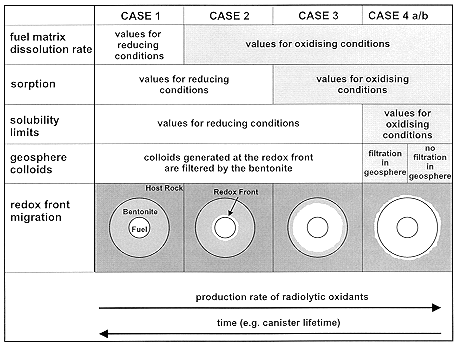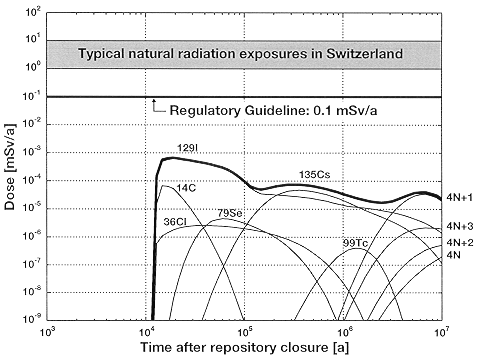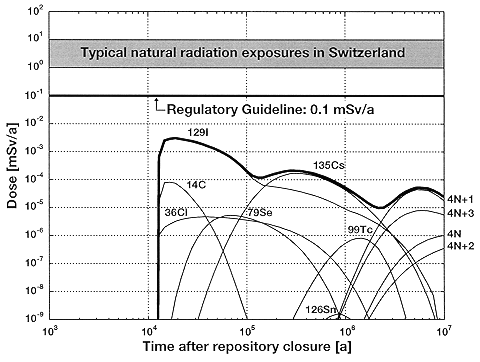J. Schneider and P. Zuidema
Nagra, Switzerland
P. Smith
Safety Assessment Management Limited, UK
P. Gribi and M. Niemeyer
Colenco Power Consulting AG, Switzerland
ABSTRACT
The results of a preliminary modelling study of radionuclide release and transport from a hypothetical Swiss repository for spent nuclear fuel are presented. The spent-fuel inventory is based on a consideration of the anticipated arisings from nuclear power generation in Switzerland. A part (at least) of these arisings will be reprocessed, with the resultant vitrified high-level waste returned to Switzerland. The decision as to whether to reprocess the remainder of the arisings is currently left open. Reprocessed waste has been considered in detail in an earlier study and the present paper is limited to the direct disposal of spent fuel. A repository concept, models and data for the release and transport of radionuclides are presented. Key uncertainties are identified, such as the evolution of redox conditions in the near field. Radiolysis may result in oxidising conditions near to the fuel surfaces, but model results show that, provided oxidising conditions are confined within the bentonite buffer surrounding the waste canisters, calculated doses are low and are insensitive to the exact position of the redox front. Higher doses are calculated in the extreme case of a redox front extending into the host rock, but, even in this case, the Swiss regulatory guideline of 0.1 mSv a-1 is not exceeded. Finally, first calculations for the direct disposal of mixed-oxide fuels are presented.
INTRODUCTION
The Swiss electricity utilities have placed contracts with BNFL (UK) and COGEMA (France) for the reprocessing of about one third of the total arisings of spent fuel from nuclear power generation, assuming a 120 GWa (electric) scenario. The options for the remainder include (i) reprocessing and (ii) direct disposal of the spent fuel, thus leaving the arisings from 80 GWa of power generation as the theoretical maximum for direct disposal. Throughout this work, it is therefore assumed that an amount of unreprocessed spent fuel corresponding to this theoretical maximum will be disposed in the repository.
On the assumption of complete reprocessing, Nagra has recently performed an integrated analysis of the disposal of high-level waste in the crystalline basement of Northern Switzerland: the Kristallin-I safety analysis (1). A key feature of the safety-assessment component of Kristallin-I is the model chain that describes quantitatively how radionuclides migrate from the repository through the geosphere to the biosphere. The results are expressed as annual individual dose to an average member of a critical population group. This dose can then be compared to the limit of 0.1 mSv a-1 specified by the Swiss regulatory guidelines (2).
No comparable work has yet been performed for the co-disposal of high-level waste from reprocessing and spent fuel. Nagra are in the process of acquiring the scientific understanding, computational tools and data that will be required in order to analyse the safety of such disposal. The modelling study presented in this paper, which considers only the direct disposal of spent fuel, represents a part of this process. The discussion of the repository concept, models and data focus on the near field, since the treatment of the geosphere and biosphere is identical to that of Kristallin-I and is discussed at length in (1).
A PROVISIONAL REPOSITORY CONCEPT
A provisional repository concept has been adopted for the calculations, in which spent fuel is packaged in canisters and emplaced co-axially in a horizontal system of tunnels deep underground in the crystalline basement of Northern Switzerland. The canister material and lifetime (i.e. minimum time at which a canister could first be breached, allowing water to access the fuel) are currently under discussion and modelling studies for a wide range of possible lifetimes will provide input for an eventual decision. For the preliminary safety calculations presented in this paper, a 104 year lifetime is assumed, corresponding, for example, to the "conservative" value used for an ACP (advanced cold process) copper-steel canister in the safety analysis of a Finnish spent-fuel repository (TVO-92, (3)). Highly compacted bentonite is used as a backfill material, providing a physical and chemical buffer between the canisters and the host rock.
THE SAFETY-ASSESSMENT MODELS AND DATA
The following describes, in broad terms, the main features of the conceptual model for spent-fuel dissolution and radionuclide transport in the repository near field. Key uncertainties, and their treatment in the safety assessment, are also given.
The time at which the canister is breached is uncertain and depends on design decisions. For preliminary safety calculations, it is assumed that all canisters fail simultaneously at 104 years after emplacement. Conservatively, neither the radionuclide transport resistance nor the redox buffering capacity of the failed canisters are taken into account in this study.
The reference-case radionuclide inventory for preliminary spent-fuel calculations is taken from the TVO-92 safety analysis (3) (1.6 tHM of UO2 fuel per canister, with a burn-up of 36 GWd/tHM), but with a total number of canisters (1620) based on a scaling of the TVO-92 inventory to a 80 GWa power-generation scenario. As a variation on this fuel type, mixed-oxide (MOX) fuel, with a burn-up of 55 GWd/tHM, is also considered. The MOX inventory has been roughly estimated by Nagra using existing tools designed primarily for the characterisation of UO2 fuel; the total number of canisters (3085) corresponds again to the arisings from 80 GWa of power generation, with the hypothetical assumption that only MOX fuel elements are used. A smaller amount per canister of 0.55 tHM is assumed for MOX fuel because of the higher heat generation and constraints on the maximum temperatures that are presently set for the surrounding bentonite (4). The partitioning of the inventory between the matrix, the gap and grain-boundary regions is uncertain for some nuclides and is currently based on recommendations of (5).
These releases are modelled as being instantaneous.
The activation products are assumed to be released congruently with the dissolving cladding, at a fractional rate of 3 ×10-6 a-1. This value is based on a cladding corrosion rate of 2 ×10-9 ma-1 (5) and a typical thickness of the cladding of 0.75 mm for Swiss fuel elements.
There is uncertainty in the evolution of redox conditions at the fuel surface, and thus also in the spent-fuel dissolution rate. For preliminary spent-fuel calculations, the fractional dissolution rate is based on data from (3). In the case of UO2 fuel, the rates are 5 ×10-6 a-1 for the time period 104 a to 105 a, 4 ×10-7 a-1 for the time period 105 a to 106 a and 2 ×10-7 a-1 beyond 106 a. Rates that are a factor of five higher are assumed for MOX fuel, due to its approximately five times higher alpha activity and the correspondingly higher generation rate of radiolytic oxidants.
Sorption parameters are taken from (1), supplemented by data from (3) and (6). Solubilities are taken from (7). Uncertainty in the evolution of redox conditions within the near field leads to uncertainty in the solubilities and sorption properties of some elements. The effects of this uncertainty are scoped by the evaluation of a range of possible cases, as described below.
A new code (SPENT (8]) has been developed to model these near-field processes. The codes RANCHMD (9) and TAME (10) are used to model radionuclide transport through the geosphere and biosphere, respectively. The models and data for the geosphere and biosphere calculations correspond to the reference case in the Kristallin-I safety analysis (1).
CALCULATIONAL CASES
The rate of fuel-matrix dissolution and, for some radionuclides, solubility limits and sorption parameters, are known to be dependent on redox conditions. These are also thought to be key parameters controlling near-field performance. The most significant processes determining redox conditions within and around the repository following canister breaching are:
Some radiolytic reductants are relatively inert (e.g. H2) and may migrate away from the fuel surfaces without recombining with oxidants, resulting in (i) net oxidising conditions near the fuel surfaces (at least initially, when the generation rate by radiolysis is high) and (ii) the establishment of a redox front at some distance away from these surfaces. Note that the position of this redox front will be time dependent.
Rather than attempt to model the position of the redox front as a function of time, four alternative cases are defined, in which time-independent redox conditions are assumed, in order to evaluate the sensitivity to this source of uncertainty. The cases are illustrated in Fig. 1. CASE 1, in which reducing conditions are assumed throughout the near field (including the fuel surface) is the most optimistic from the point of view of safety, but is considered difficult to support on the basis of current information and is not therefore evaluated. The cases for which calculations are performed are:
CASE 2: The redox front penetrates only a small distance into the bentonite (compared to its total thickness): sorption parameters and solubility limits are based on reducing conditions.
CASE 3: The redox front penetrates a considerable distance into the bentonite, but not beyond: sorption parameters for the bentonite are based on oxidising conditions and solubility limits are based on reducing conditions.
CASE 4: The redox front penetrates into the host rock: sorption parameters and solubility limits in the near field are based on oxidising conditions.
Where redox-sensitive radionuclides migrate across the redox front, from a region where oxidising conditions prevail (generally higher solubilities) to a region where reducing conditions prevail (generally lower solubilities), the resulting precipitates may take the form of colloids. If the redox front is located in the bentonite (CASES 2 and 3), the fine structure of the bentonite pores prevents the migration of these colloids and only solute transport needs to be considered. If the redox front penetrates into the geosphere (CASE 4), colloids may be transported through fractures in the host rock and, if they are prevented (due, for example, to their size) from diffusing into the stagnant pore water of the adjacent wall rock, then the radionuclides associated with these colloids would not be subject to the retarding effects of matrix diffusion and sorption on matrix pore surfaces. The distances over which such colloids would be transported through the host rock are highly uncertain and two extreme situations, within CASE 4, are evaluated in order to investigate the effects of this uncertainty:
CASE 4a: Colloids either do not form, or are transported only a short distance through host-rock fractures before destabilising. Only solute transport is modelled in the geosphere.
CASE 4b: Colloids are transported, without either filtration or retardation, through host-rock fractures. Consequently, to model this case, all radionuclides escaping from the near field are transferred instantaneously to the biosphere.
CASES 2, 3 and 4a/b are evaluated for UO2 spent fuel. From a consideration of the inventory of near-field reductants, which is large in comparison to the integrated production of radiolytic oxidants (see, e.g., (11)), CASE 2 is assumed to be the most likely and is taken as a reference case for studies of sensitivity to fuel type (both UO2 and MOX fuels are considered). However, the realism of CASE 2 depends not only on the inventory of reductants but also on their accessibility and on the kinetics of the relevant redox reactions. CASES 3 and 4a/b are therefore currently not excluded.

Fig. 1. Calculational cases to evaluate the sensitivity of the annual individual dose to the position of a redox front.
RESULTS
UO2 Spent Fuel; The Reference Case
Fig. 2 shows the calculated dose as a function of time for a UO2 spent-fuel repository with redox conditions defined according to CASE 2 (reference case). The following observations are made:

Fig. 2. Annual individual dose from a repository for UO2 spent fuel as a function of time with redox conditions defined according to CASE 2 (reference case). The dose curves for individual radionulides that are most important in defining the shape of the total dose curve are also shown.
Sensitivity to Redox-Front Position
Fig. 3 shows the calculated dose as a function of time for a UO2 spent-fuel repository with redox conditions defined according to CASE 2 (reference case), CASE 3 (near-field sorption parameters based on oxidising conditions), CASE 4a (near-field solubilities and sorption parameters based on oxidising conditions) and CASE 4b (as CASE 4a, but with the hypothetical assumption of instantaneous radionuclide transfer from the near field to the biosphere):

Fig. 3. Annual individual dose (summed over all radionuclides) from a repository for UO2spent fuel as a functio of time in CASE 2, CASE 3 and CASE 4a/b (see Fig. 1 and text for a definition of cases).
Sensitivity to Fuel Type
Fig. 4 shows the calculated dose for a hypothetical MOX spent-fuel repository, with redox conditions defined according to CASE 2. The following observations can be made:

Fig. 4. Annual individual dose from a repository for MOX spent fuel as a functi of time with redox conditions defined according to CASE 2. The dose curves for individual radionuclides that are most important in defining the shape of the total dose curve are also shown.
DISCUSSION AND CONCLUSIONS
A modelling study has been presented considering direct disposal of spent fuel in a hypothetical repository deep underground in the crystalline basement of Northern Switzerland. The calculations described in this paper are preliminary and further work will be required, for example:
Therefore, the results should be interpreted with caution; further iterations are clearly needed using more reliable data and models as indicated above. Nevertheless, the following statements can be made: (i) Even in the case that gives the highest dose (CASE 4b); i.e. where it is assumed that the redox front has moved beyond the bentonite into the adjacent host rock and where no credit is taken for geosphere retention, the Swiss regulatory guideline of 0.1 mSv a-1 is not exceeded. (ii) The reference case for this study (CASE 2); i.e. where it is assumed that the redox front has penetrated only a small distance into the bentonite, leads to a total dose curve with a maximum that lies more than two orders of magnitude below the Swiss regulatory guideline of 0.1 mSv a-1. (iii) First calculations for a hypothetical repository for MOX spent fuel yielded doses comparable to those obtained for a UO2 spent-fuel repository (assuming redox conditions defined according to CASE 2 for both fuel types).
REFERENCES